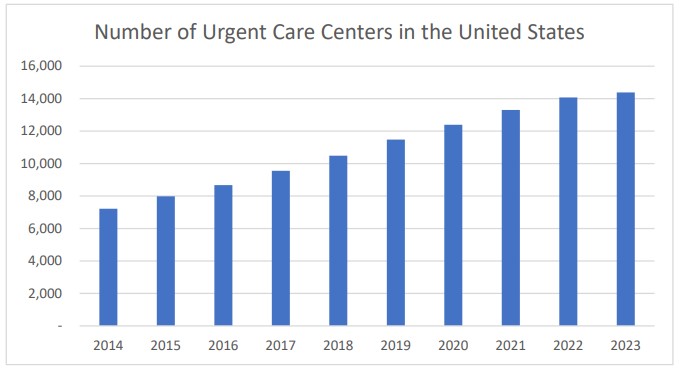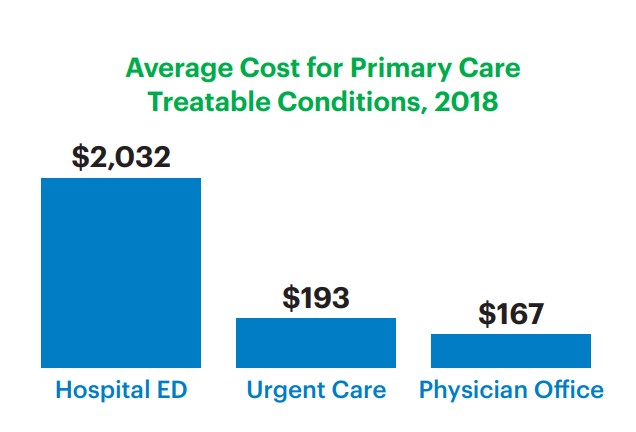Accidents happen. That’s why 139.8 million people ended up in emergency rooms in the US in 2021. On the other hand, 1 billion Americans visited a physician’s office, and 50.3% of them ended up in primary care in 2019. So, what is the difference between urgent care vs primary care?
Knowing when to use urgent care vs primary care is important not only for getting better patient outcomes but also saving on unnecessary healthcare costs.
In this guide, we will tell you all about primary vs urgent care, their benefits, costs, and insurance coverage. We will also tell you about more personalized solutions like concierge urgent care and concierge primary care to help you understand all your options.
Ultimately, we will help you make an informed decision between the two based on your own health needs. Let’s jump right in.
Primary Care Vs Urgent Care: Key Takeaways
Urgent care provides immediate treatment for conditions that require prompt attention, often without the need for an appointment, while primary care focuses on long-term health management, regular check-ups, and the ongoing relationship between a patient and their healthcare provider
Here’s a quick look at the key similarities and differences between urgent care vs primary care:
Urgent care Primary care Level of care Designed for immediate, non-emergency situations. Focused on long-term health management. Services available Sudden health concerns like minor injuries, flu symptoms, and sprains. Routine checkups, chronic disease management, immunizations, etc. Access and availability Walk-in services with extended hours. Usually requires scheduled appointments. Cost More expensive. Less expensive.
What is Urgent Care?

Urgent care, by definition, is a healthcare model that serves patients who come in with non-life-threatening health issues that still need quick care like fractures or flu symptoms.
It is designed to handle symptoms and conditions that aren’t severe enough for the ER but urgent enough to not wait for a primary care appointment.
Let’s dive a little deeper and understand the benefits, services, care level, and more about urgent care. This will help you understand the key components of urgent care vs primary care later.
Benefits of urgent care
Urgent care is such a popular healthcare model for many reasons, including its walk-in availability, extended hours, and quick service for immediate issues. In a way, it is similar to concierge healthcare services which are available 24/7 and even through telehealth.
Symptom coverage of urgent care
If you’re experiencing sprains, minor cuts, infections, mild asthma attacks, or similar non-life-threatening symptoms, urgent care is the place to go. Essentially, if you have issues that cannot wait until you get an appointment with your primary care physician, you should visit an urgent care center.
Services urgent care covers
Usually, urgent care clinics offer treatment for minor injuries, infections, flu symptoms, sprains, and more. Additionally, this is the place to go for urgent X-rays and tests for quick diagnostics.
Now that you know the ins and outs of this clinic type, let’s now help you understand the differences between urgent care vs primary physicians.
What is Primary Care?

Primary care is the place to go when you need help managing long-term health and preventive medicine. PCPs (primary care providers) give more personalized medical attention and maintain your health records in-house.
Essentially, primary care is the first point of contact for most health concerns and is the key to overall health management. To understand this model a bit better, let’s talk about its benefits, services, and more.
Benefits of primary care
The main advantages of using primary care are its continuity of care with a trusted physician and personalized healthcare plans that take your medical history into account thanks to care coordination services.
This model is especially beneficial for patients with chronic health issues who need long-term monitoring and support.
Symptom coverage of primary care
Usually, primary care clinics treat almost everything, including diabetes management, hypertension, wellness checkups, and more. Primary care is the first place you’d go with a symptom that has been bothering you for a couple of days or even months.
Services offered in primary care clinics
PCPs usually provide annual checkups, immunizations, screenings, and chronic disease management.
Having covered the main differentiators between primary care vs urgent care, let’s now talk about how you should choose where to go.
When To Go to Urgent Care vs Primary Care?
There are over 123,000 primary care clinics in the US and only 10,728 urgent care clinics are available.
As the names suggest, urgent care is for more urgent cases while primary care is for general health problems. Nevertheless, if you’re experiencing a health issue, it can be tough to understand the type of clinic you need to visit.
So, Let’s talk about when you should visit urgent care vs primary care depending on the health problems you are experiencing.
When to Go to Urgent Care?
You should choose to go to an urgent vs primary care clinic when:
- You’ve injured a body part and have a sprain, minor fracture, or strain
- You have a cut or wound that requires stitches
- You have flu symptoms or a high fever that isn’t going away
- You have an infection that needs treatment such as a sinus infection or UTI
- You are experiencing an allergic reaction that isn’t life-threatening
- Any other health issue that requires urgent care yet is not severe enough to visit the ER
When to Go to Primary Care?
Now, let’s talk about when you should choose to visit a primary care physician vs urgent care.
- You need a routine health checkup
- You need help with managing a chronic disease like diabetes or hypertension
- You need to get vaccinated or an immunization
- You have a long-term health concern you want to address
- You are looking for specialist doctor referrals for another problem
- You are experiencing a non-urgent health issue that you don’t know how to approach
Cost Differences Between Urgent Care and Primary Care

One of the major differences you need to know about is urgent care vs primary care costs. Generally, urgent care costs more than primary care because of its immediate, walk-in nature. Urgent care clinics are also open for extended hours, meaning they are more accessible and give higher value in a time of need.
While these costs are not comparable to the cost of concierge medicine, they still have a value factor that is lower compared to the customized care you would get in a concierge clinic.
When it comes to primary care costs, routine visits to your PCP are more affordable and offer preventive care. Usually, preventive services are fully covered by insurance.
Ultimately, the costs between urgent care vs primary care will vary depending on your insurance coverage, the type of care you need, and whether your health issue is routine or urgent.
How Insurance Covers Urgent Care and Primary Care
The costs of urgent care vs primary care you’ll need to pay are highly dependent on your insurance coverage. What sort of out-of-pocket expenses are you looking at and what will your insurance cover with each type of healthcare center?
Let’s talk about the way insurance works for both of these medical models.
Insurance for urgent care
Most insurance plans will cover urgent care visits, but your copays and deductibles will vary. It is very important that you check your specific coverage to understand the potential costs you will face.
In general, urgent care visits have higher out-of-pocket costs when compared to primary care. This gap becomes even bigger if you visit an urgent care center after-hours.
Insurance for primary care
When it comes to primary care, insurance companies usually cover preventive services and routine visits to your doctor.
Most of the time, preventive care services will be fully covered and there will be no out-of-pocket costs because insurers want patients to be engaged in their long-term health and attend their regular health checkups.
Making the Right Healthcare Choice with Comprehensive Health Support
Now, you have almost all the information you need to be able to make your choice between going to the emergency room vs primary care vs urgent care. When making your decision, it’s important to take into account both care levels and the value of having personalized plans.
Among all the available options, there’s one more that you should consider, which is concierge care. When you’re choosing between concierge medicine vs primary care, consider the following.
Concierge care is a highly personalized model of healthcare that is available 24/7, includes coordinated referrals, and an immediate, direct connection to advanced primary care providers through telemedicine and more.
Here at WorldClinic, we assist you in understanding the type of care you need based on your specific health needs. We guarantee consistency and continuity of care through follow-ups and long-term health planning, making sure that you get a seamless, premium healthcare experience.
While concierge medicine insurance isn’t usually available, the quality of care is worth the price tag for those who value their health.
Conclusion
Both urgent care and primary care have their role to play in the huge landscape of healthcare. When managing your health, it’s important to be able to choose between urgent care vs primary care for different types of problems.
Remember that urgent care is designed for non-life-threatening situations that need immediate medical attention. On the other hand, primary care has the benefit of long-term health management based on your medical history.
If you’re experiencing a health problem and need to choose between urgent care vs ER vs primary care, don’t forget to also consider WorldClinic’s 24/7 concierge care.
We can give you access to both urgent and primary care services, making sure that your health is a priority at every stage.
So, if you’re ready to treat yourself to personalized, comprehensive, and on-demand healthcare support, we recommend you explore our concierge membership plans.
Primary Care Vs Urgent Care FAQs
What are some disadvantages of urgent care?
Urgent care is designed for health issues that need immediate care. Because of this, it lacks the continuity of care that is available with primary care.
Doctors in urgent care don’t usually have access to your medical history, which makes the treatments less personalized. Additionally, urgent care is usually more costly, especially without insurance coverage.
Is primary care the same as urgent care?
No, primary care and urgent care serve different purposes. Primary care is the first point of contact for long-term health issues and provides routine checkups, chronic illness monitoring, etc. On the other hand, urgent care is for non-life-threatening conditions like minor injuries, flu symptoms, infections, and other walk-in cases.
Why do so many people go to urgent care?
Urgent care gives quick and convenient care without the need for an appointment, which is why people often go to such clinics. These centers are open during irregular office hours, so they can treat people with sudden health issues. If you can’t wait for an appointment with your physician or your issue isn’t severe enough for the ER, urgent care is the solution.
What are the slowest times in an urgent care?
Early mornings or mid-afternoons on weekdays are usually the slowest times for urgent care centers. If you’re planning a visit, you should avoid peak times like lunch hours, weekends, or evenings. You should also avoid Mondays or the days after a holiday.
What classifies a patient as urgent?
If a patient has a health problem that is not life threatening but still needs quick medical attention, they are classified as urgent. This includes issues like minor fractures, cuts that need stitches, infections, asthma flare-ups, and more.


